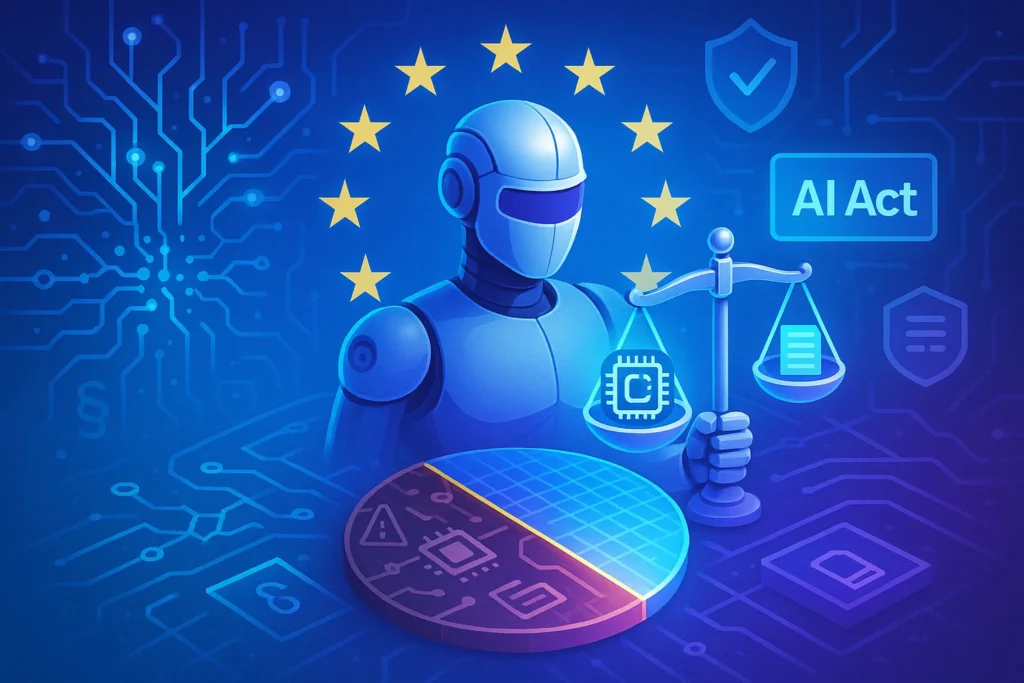-This post may contain affiliate links. If you click on one and make a purchase, I may earn a small commission at no extra cost to you.-
🚀 Intro: The Moment AI Met the Law
For years, AI evolved faster than any government could keep up with. From facial recognition to deepfake generation, innovation raced ahead—unbound and unchecked.
That just changed.
In 2025, the European Union passed the AI Act—the first major attempt to legally govern artificial intelligence on a global scale. And it’s not just for companies in Europe.
This post breaks down:
-
What the AI Act actually says
-
Which tools and companies are affected
-
How global regulation is taking shape
-
And what YOU need to do if you build or use AI
The EU’s push to regulate AI isn’t happening in a vacuum. In fact, it’s part of a broader trend of governments stepping in to rein in tech giants. From data privacy to antitrust lawsuits, the regulatory spotlight is getting hotter. If you’re curious how this shift plays out beyond AI, check out our deep dive into Big Tech Antitrust: What It Means for the Future of Tech Giants.
⚖️ 1. What Is the EU AI Act?
The EU AI Act is the world’s first comprehensive AI law—a legal framework built to classify, control, and supervise AI systems based on risk levels.
Instead of banning AI outright, the EU chose a layered approach:
-
Unacceptable risk systems are outright banned
-
High-risk systems face strict regulation
-
Limited-risk systems require transparency
-
Minimal-risk systems remain mostly untouched
🧠 Key Pillars of the Act:
-
Focus on human rights and data protection
-
Mandatory risk assessments, documentation, and human oversight
-
Enforced by both national authorities and a central AI Office
✅ Micro-UX Prompt:
“If your AI can harm people, it’s now your legal problem.”
🛡️ 2. High-Risk vs. Low-Risk AI Systems
At the heart of the AI Act lies a risk-based classification system:
| ⚠️ Risk Level | 🧪 Examples | 📋 Regulation Requirements |
|---|---|---|
| ❌ Unacceptable | Social scoring (à la China), manipulative voice AI | Completely banned in the EU |
| 🔴 High Risk | Biometric ID (facial recognition), AI for hiring or medical diagnostics | Must undergo audits, logging, human oversight |
| 🟠 Limited Risk | Chatbots, recommendation engines | Disclosure required (e.g., “This is an AI system”) |
| 🟢 Minimal Risk | AI filters, spam detection, entertainment bots | No mandatory compliance |
🌍 3. Who Needs to Comply?
This law doesn’t just apply to European companies. If any part of your AI product reaches users in the EU, you’re expected to comply.
That includes:
-
🧠 AI SaaS platforms like GPT-powered apps
-
🧩 API providers offering AI features globally
-
📦 Open-source projects with significant EU user bases
Even non-EU startups must meet requirements if their tools touch European users.
📥 Need a Compliance Shortcut?
Enter your email below to instantly download our free PDF:
“AI Compliance Checklist for Founders”.
It’s a one-page guide to help you align with the EU AI Act—without legal confusion.
🔒 No spam. Just actionable AI insights, when it matters.
🔗 4. The Global Ripple Effect: Who’s Copying the EU?
The EU may be first—but it won’t be the last. The AI Act is already triggering a global domino effect.
Here’s what’s happening around the world:
| 🌐 Region | 🔍 Response |
|---|---|
| 🇺🇸 United States | White House’s AI Executive Order & NIST AI Risk Management Framework (mostly non-binding, but influential) |
| 🇬🇧 UK | AI White Paper (light-touch regulation model) |
| 🇨🇦 Canada | Draft Artificial Intelligence and Data Act (AIDA) |
| 🇯🇵 Japan | Voluntary AI governance guidelines for developers |
| 🇧🇷 Brazil | Bill 21/20: Aiming for rights-based AI regulation |
| 🇨🇳 China | Strict state-driven model; already regulates deepfakes, recommender algorithms, and social scoring |
Even countries with no laws yet are watching Europe closely.
🧭 Bottom Line: The EU is quietly becoming the global standard-setter for AI governance.
As regulation rises, so does innovation. Google’s Gemini AI is a perfect example—an evolving model that may soon require deeper transparency under new legal frameworks. For the latest on how Gemini is shaping the AI landscape, check out: Google’s Gemini AI Update.
💼 5. How It Affects Your AI Product
So what does all this mean for real tools in the market?
Let’s break it down:
🎯 GPT-Powered SaaS Platforms
Example: An AI writing tool used in Germany
-
Must clearly disclose AI use
-
Might need a risk log and human fallback if outputs affect decisions
🎯 Hiring Platforms Using AI
Example: Resume scoring or video interview analyzers
-
Classified as high-risk
-
Requires documentation, regular audits, and bias checks
🎯 AI Content Generators
Example: Marketing content generation for EU clients
-
Need a visible disclaimer
-
Likely required to document training data sources and limitations
💡 Even small startups could be asked to prove how their AI works.
⚠️ Coming Soon: A “CE Mark for AI” (like for electronics) may become required on compliant AI tools in the EU.
Many GPT-powered SaaS tools are already making waves in marketing—writing copy, generating ideas, and even managing content. But under the AI Act, these tools may need to disclose how their outputs are generated and whether humans can override them. If you’re using or building AI agents for marketing, this post might give you valuable insights: AI Agents for Marketing.
🧨 6. The Backlash and Criticism
Not everyone is cheering for the AI Act.
While the law aims to protect users and prevent harm, many startups, developers, and legal experts have raised serious concerns.
🧩 What Critics Are Saying:
-
“It’s innovation-killing.”
Smaller startups argue they don’t have the resources for audits, legal reviews, and compliance teams. The fear? Only big players will survive. -
Ambiguous definitions.
Terms like “high-risk” and “subliminal manipulation” are seen as too vague. Companies worry they’ll get caught in legal gray zones. -
Overreach concerns.
Critics say the law puts too much responsibility on developers for downstream uses—especially when tools are open-source or repurposed by others. -
Enforcement bottlenecks.
Will regulators have the technical skill to fairly audit advanced models? Some fear a gap between lawmakers and engineers.
📣 Despite this pushback, the EU has signaled that enforcement will be “proportionate” and updated over time. Still, the tension between innovation and regulation is very real.
✅ Micro-UX Prompt:
“Every rule has a cost—but no rules have a cost too.”
🛠️ 7. How to Prepare as a Founder or Developer
So… what now?
If you’re building or using AI tools—even outside the EU—you’ll want to get ahead of compliance instead of reacting under pressure later.
Here’s a practical checklist to start today:
✅ Step-by-Step Playbook
-
Determine your risk level
-
Use the EU’s classification (high, limited, minimal)
-
Consider impact on safety, access to services, and human rights
-
-
Map your AI system
-
What’s your model’s purpose?
-
What data is it trained on?
-
Who are the end-users?
-
-
Build transparency
-
Add AI disclosures in your UI
-
Make limitations and intended use cases clear
-
Be upfront about any automation
-
-
Add human oversight
-
Can a human override or audit outputs?
-
Is there a fallback if the model fails?
-
-
Keep records
-
Document your training data sources
-
Log model updates and performance checks
-
Keep an internal “risk register”
-
-
Align with known standards
-
Use NIST AI RMF or ISO/IEC 42001 as your baseline until EU rules become mandatory
-
These frameworks help fill current gaps
-
💬 If this sounds overwhelming, start with just transparency + user disclosure. It’s the most basic form of compliance—and already builds trust.
🧠 Nerd Verdict
AI is no longer a legal gray area.
The EU AI Act signals the end of AI’s “Wild West” phase. If your product has real-world impact, legal compliance is now part of your dev cycle.
✅ Serious players will start building trust-by-design, not just features.
🌍 The world is watching Europe. And odds are, your country is next.
❓ FAQ: Nerds Ask, We Answer
💬 Would You Bite?
Imagine this: You’re using an AI tool that helps write your emails or resumes.
But you have no idea how it works—or what it does with your data.Would you still use it?
🧭 Or would you prefer tools that show you what’s behind the curtain—with legal protections to back it up?
👇 Let us know your take.



